
How many board games do you know about quantum physics and subatomic particles? I’m guessing none–unless you’ve already heard of Antimatter Matters. Scientists in the not-so-distant future are attempting to construct atoms from individually captured elementary particles–quarks, photons, gluons, and electrons. It successfully raised funding on Kickstarter a year ago, and is now available for general purchase.
At a glance: Antimatter Matters is for 2 to 6 players, ages 11 and up, and takes about 45 minutes to play. It retails for $69.00. I did play with my 10-year-old and found it worked fairly well, though some of the cards have a lot of text on them and may need clarification. You could also play with younger kids by simplifying the game a little or playing cooperative or team mode.

Components:
1 Board + Spinner Arrow
18 Up Quarks (wooden cubes)
18 Down Quarks (wooden cubes)
12 Gluons (wooden Y-shapes)
6 Photons (wooden X-shapes)
6 Electrons (wooden cylinders)
6 Scientist Pawns
6 Proton + Electron Mats
6 Neutron Mats
1 Turn Token
4 Quantum Entanglement Tokens
2 Energy Dice (8-sided)
105 Cards
The game was manufactured by Panda GM (which gets a lot of business from Kickstarter board games these days), and is excellent quality. The wooden pieces are all oversized and colorful–even the meeples are larger than usual–but what’s great is that the designers took color-blindness into account. The scientist meeples not only have different colors, but also have different symbols painted on their backs.
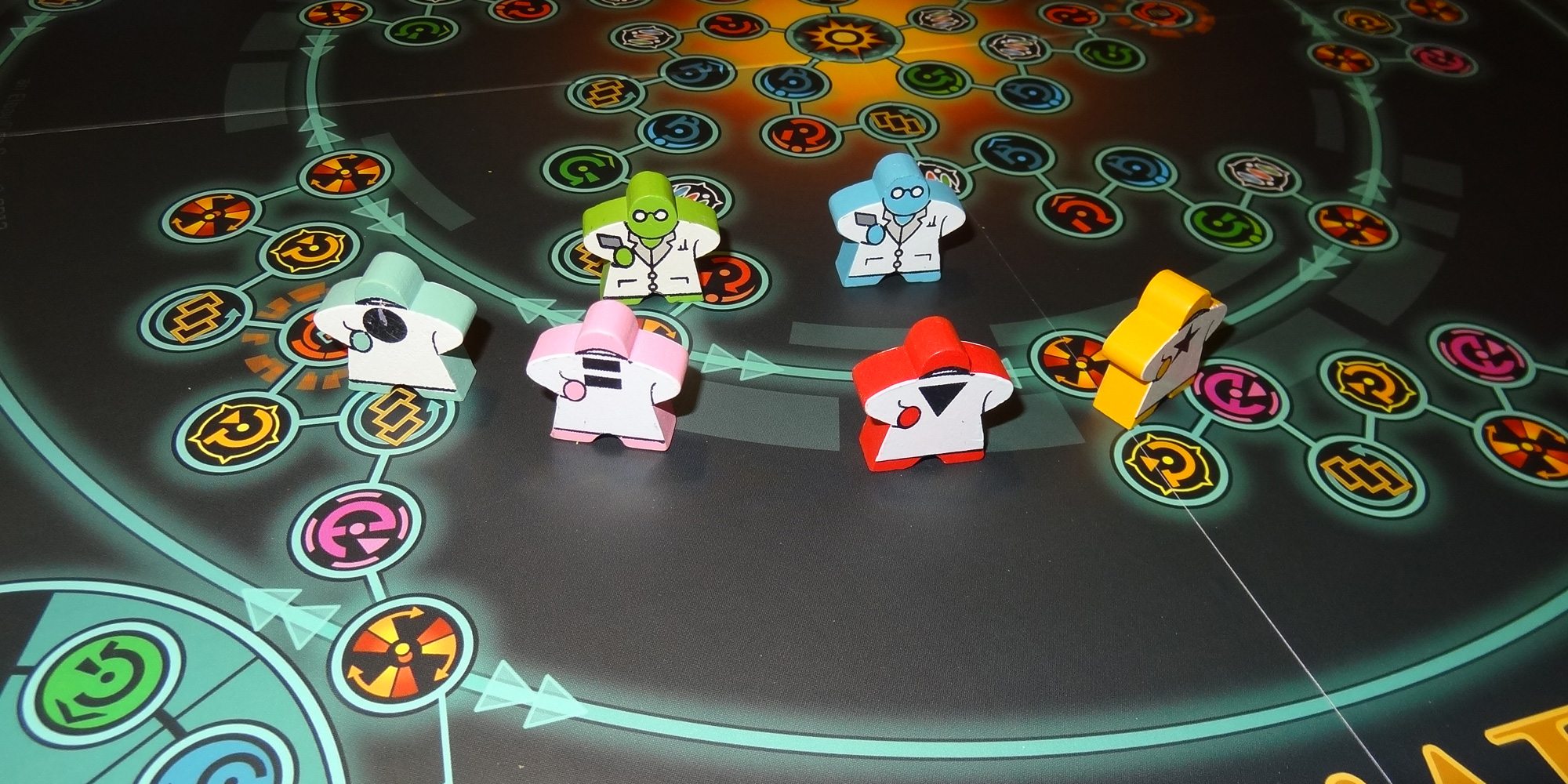
The various wooden pieces are also color-coded to match the spaces on the board (and on your player mat), but the glyph-looking symbols are also actually letters: R, G, B for Red, Green, Blue, and E, P for Electron, Photon. (The Gluons have their own three-oval symbol.) It gives the board a really great graphic look, while still being pretty easily understandable. There are subtle differences between the “up” and “down” versions of the quarks on the board.
The board is designed to look like an atom, with a middle ring that separates the nucleus from the electrons. Appropriately, you can collect the particles to make up the nucleus (quarks and gluons) within the middle ring, and electrons and photos outside the middle ring.
The artwork is by a Portland-based artist, Thomas Conrad Rigby. Elbowfish has chosen to use local artists for their games and to feature their names prominently, which is something I haven’t seen as often.
How to play:
There are a couple different modes and ways to handicap the game: you can play in regular competitive mode, team mode, or fully-cooperative mode. When competing, each player can use regular rules, challenge rules, or even have harder objectives to balance out the difficulty for less experienced players. I’ll explain the basic competitive game, and then mention a few changes for the other modes.
The goal of the game is to successfully build an atom by collecting all the necessary subatomic particles, and then get to the center of the board.

Starting off, each player puts their scientist meeple on a space in the middle ring (they must all be in different spaces), and takes a “Proton + Electron” mat, which represents a Hydrogen Atom. (For more challenging modes, you also take a Neutron mat, which means you’re building a deuterium atom.) The cards are shuffled and each player is dealt 4 cards. The “Immediate” cards (which are yellow) are discarded and replaced. There are also a few cards for cooperative mode which are removed from the deck. For standard mode, you only use 1 of the movement dice, so the other is returned to the box.

Each turn consists of the following phases: roll and move, play movement cards, play action card, draw cards.
First, you roll the die and move that many spaces. When you move, you may choose the direction, either “in” (toward the center) or “out” (away from the center), but all of your movement during a turn must be in the same direction. Moving clockwise or counterclockwise around the middle or outer ring can be done whether you’re moving in or out. Because of the Pauli Exclusion Principle, you can’t land on the same space as another player, so you’ll bounce back one space. If you move into the center, your movement ends there.
Then, you take the action shown on the space. If it’s a particle, you take the corresponding token and place it on your mat–as long as you don’t have one already. One note is that you’ll need 1 down quark and 2 up quarks, and all three must be different colors. So, for instance, if you have a red down quark already and you land on a red up quark, you don’t take anything.
There are some spaces that let you draw a card, some quantum tunnel spaces that jump you to the matching tunnel space elsewhere on the board, and an Antimatter space that forces you to spin the spinner, which can cause you to lose particles you’ve collected or (very occasionally) draw a card or jump to the center space.
After you’ve moved and taken the action, you may then play any number of movement cards–these typically move you a number of spaces in or out. You move in/out based on the cards you played, and then again take the action of the space you land on.
Then you may play one action card–these will have various effects, sometimes on yourself, and sometimes on other players.
Finally, you draw two cards, discard down to 6 cards, and end your turn. If you draw an Immediate card, you must play it immediately, and do not draw a card to replace it.
The first person to collect all of the particles on their mat and reach the center wins the game.

There are lots of different cards available. Shields (“Containment Fields”) protect you from other actions, and some even reflect the action back onto the player who played the card. There are others that let you draw cards, steal cards from another player, or force everyone to pass cards clockwise or counterclockwise. Color Shift cards change the color of all the quarks on a player’s board, and can be used defensively or offensively.
One of the most interesting cards is the Quantum Entanglement. If you draw one, it is immediately placed in front of you. The next player to draw a Quantum Entanglement card is now entangled with you, and you mark both of your scientists with the markers. Whenever one scientists moves, the other moves with it, in or out, also taking whatever actions it lands on. There are various things that break the entanglement, but it can also be used to cooperate with another player or disrupt another player.
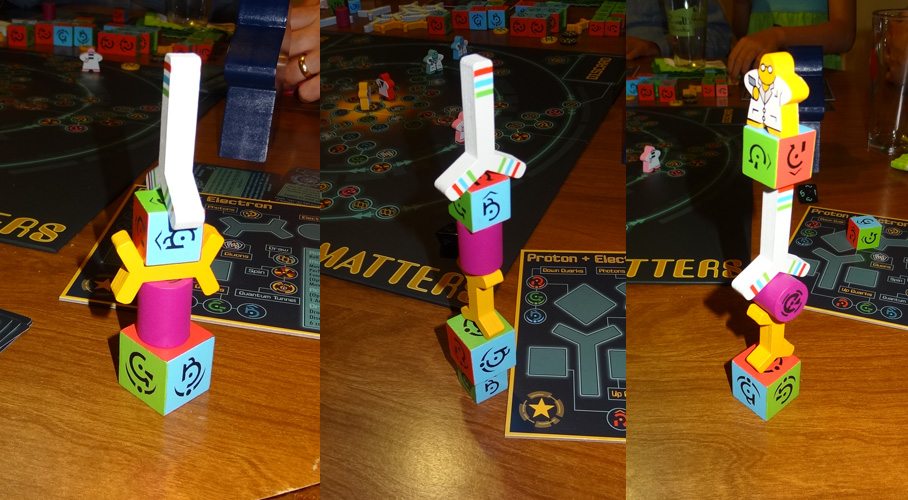
For Team Mode, you work together in teams–each player gets a scientist meeple, but shares one mat, and you use both movement dice. The total number rolled is the total movement points the team members must move. It’s fairly similar, but then you can also throw in additional mats to make more complex atoms (like Lithium-6).
In Cooperative Mode, you work together to construct the most complex stable atom you can, but you’ll start losing particles. You start with a single Proton + Electron mat. The Antimatter Sensor Alert cards and some shield cards are removed, and the cooperative Antimatter Hazard cards are added to the deck.
There are a few other rule changes: whenever a scientist lands on a quark color of a type that you’ve already collected, the colors for the collected quarks will shift. When you complete a mat, then you’ll add another mat, alternating between Proton + Electron and Neutrons. If you lose a particle to an Antimatter spin, that particle is removed from the game, not placed back into the supply.
The game ends when you can no longer create a stable atom with the particles left in play. The rulebook lists the various atoms that can be built, with Carbon-12 being the most complex, using all of the mats.
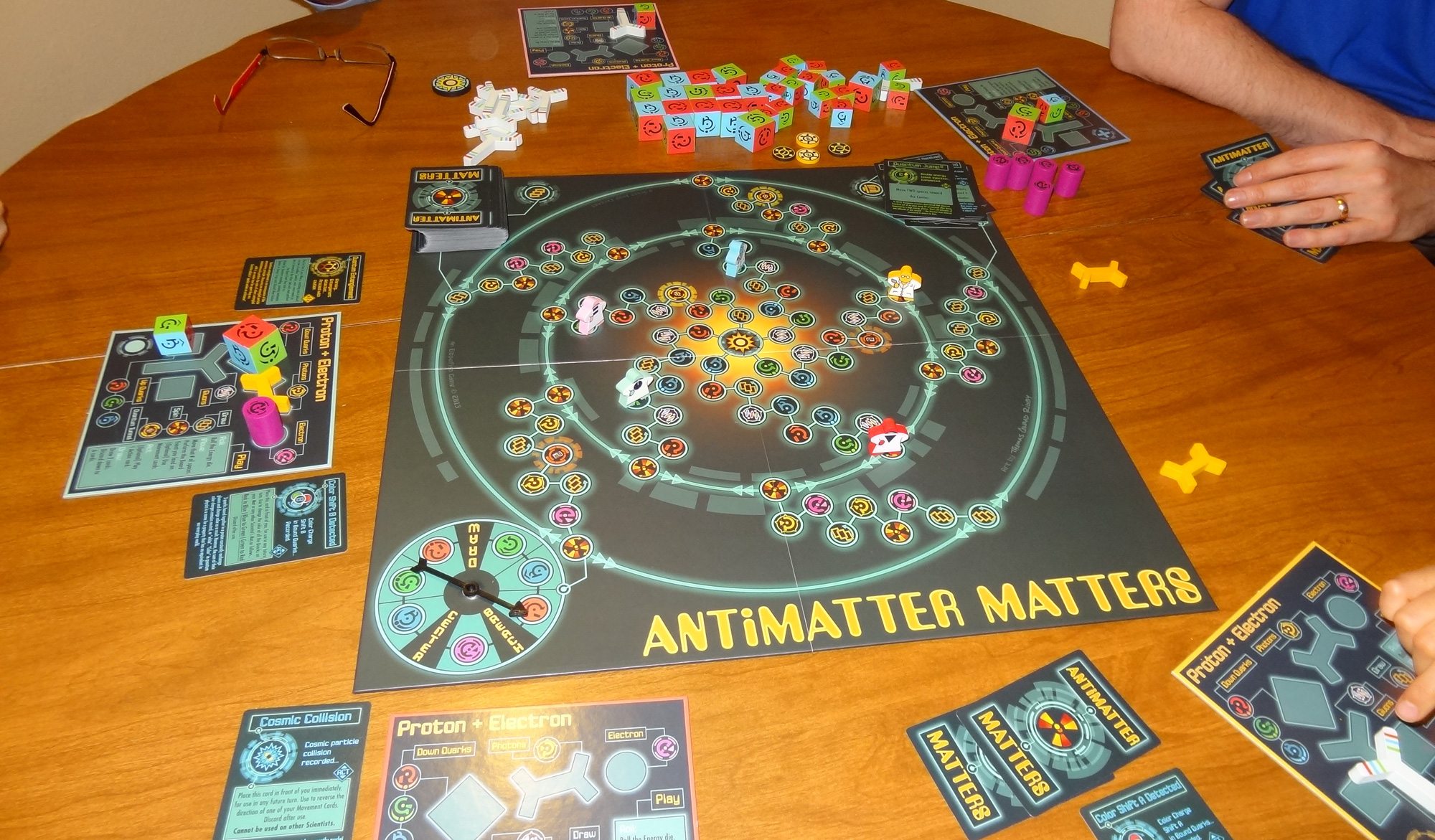
The Verdict
Antimatter Matters was first conceived by Scott Isler while he was running an after-school program. David and Leana Galiel formed Elbowfish games to make games that are fun to play, while also making you think, and Antimatter Matters was a great fit. While not all of their games will be STEM-related, this one certainly is. It was fun to play this game, designed and produced by a father-daughter team, with my own daughter. After the game, we had a really great conversation about gaming, education, and all sorts of other topics. I may need to invite them onto my Bounded Enthusiasm podcast sometime.
Now, I know, I know, some of you gamers out there read “roll and move” and are immediately skeptical. And the description of the turn does seem kind of simple: roll and move, collect things, get to the middle. But what doesn’t show up in that description is the way that the board is designed and all of the various cards that can come into play.
First, yes, there’s a bit of luck: you roll and get to move that many spaces. However, because it’s not a linear path, you do have some choices in the direction you choose to go. Also, the opportunity to play movement cards can land you on the space you want.
There are five “spokes” leading out from the center, and then when you get to the middle ring you must go along it to reach another spoke out to the outer ring. Each of the inner ring spokes, where you collect quarks and gluons, is missing at least one type of quark. For instance, one path has no green down quark, and another is missing the blue up quark. So depending on what you’ve collected, there’s always a chance you’ll have to make your way to another spoke to get that last quark.
The middle and outer rings (and some of the spaces in the outer region) are all made up of antimatter spaces–which means that crossing from one to the other can be risky. Spinning the antimatter spinner is generally bad for you, because you lose whatever piece the spinner lands on if you have it. So the more pieces you’ve collected, the worse the spinner can be. However, it can also be a card draw (good) or a free trip to the center (good or bad, depending on where you want to be).
If you want to avoid stepping on antimatter spaces in the middle ring, you could always look for a quantum tunnel spot, which jumps you across the barrier without having to touch the ring itself. The trade-off there, though, is that those spokes have one less particle space because of the tunnel. Once I was playing the game, I was impressed with the way the spaces had been planned out–there was definitely a lot of thought put into it.
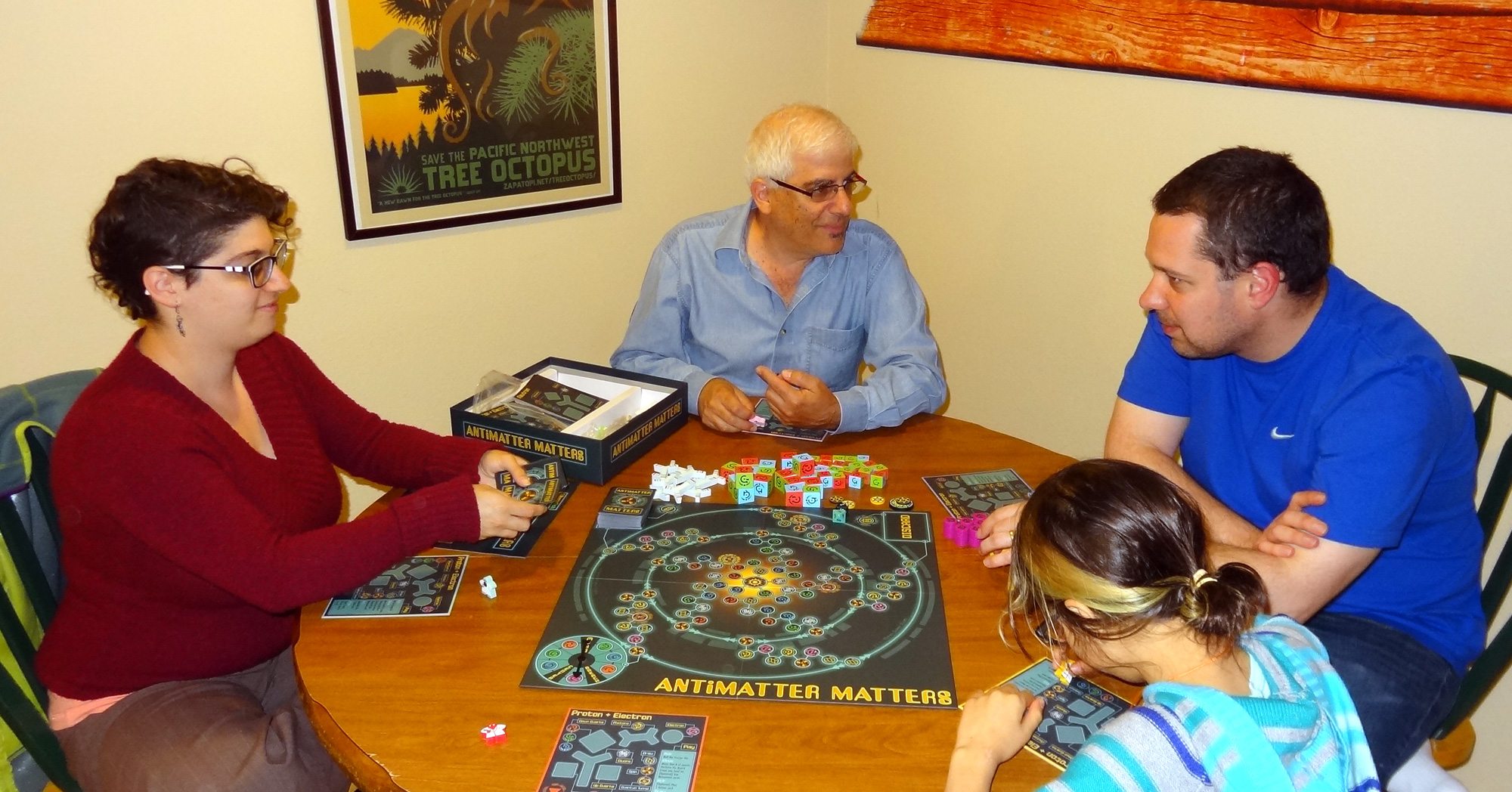
When a player has collected all of the pieces and is racing to the center, the other players do tend to try to disrupt them, and there are various ways to do so, but only for so long. One of the most interesting ways, though, is through quantum entanglement (which happens by chance). If you happen to get entangled with somebody who is on their way to the center with a completed atom, you could simply keep moving out, and try to land them on an antimatter spinner, in which case they have a pretty good chance of losing particles.
Another thing I liked about the game was the way quantum physics is integrated into the mechanics, but it’s not done in a heavy-handed way. The rulebook has a couple of very brief asides, such as pointing out that there seem to be more left-handed than right-handed known particles in the universe, so play moves to the left. And certainly knowing the names of subatomic particles is a simple part of quantum physics. The cards also have facts at the bottom of each card–of course you can play the game without reading all of that text, and the first time you play you’ll probably be focused on just the actual effect of the card. But once you’re familiar with the game and don’t need to read the action itself, you can easily move on to reading why “quantum sink” means you move away from the center.
I played with my 10-year-old, and she didn’t have any difficulty grasping the basic gameplay, and only needed help with a few of the cards. I think my 7-year-old would probably be able to play in team or cooperative mode until she gets used to the various cards and doesn’t have to figure them out on her own. But that’s not to say it’s a kids’ game and won’t be interesting for older players. While the theme may fit a niche market–I’m thinking physics teachers would get a kick out of it–the gameplay isn’t dumbed down, either. It’s not a super-deep strategy game, but it does offer some depth.
And the components are great. I really like the look of the board, and the wooden components are huge. The smaller up quarks are already larger than a standard six-sided die, and the larger down quarks are a full inch tall. I like that the game is bright and has vivid colors, but is also designed with color-blindness in mind. The text on the cards may be a little dense for players with low vision, however.
The price is on the higher end for board games, but a lot of that is due to the huge amount of wooden components included. Currently Antimatter Matters is available directly from Elbowfish, from various game stores in Oregon and Washington, and from Amazon. They’re working on getting it into science museum stores nationwide (including OMSI here in Portland), and I think it’ll be a great fit there.
If you want a game with a unique theme, fantastic components, and a good balance of entertainment and education, check out Antimatter Matters!
Disclosure: Elbowfish Games provided a copy of the game for review.



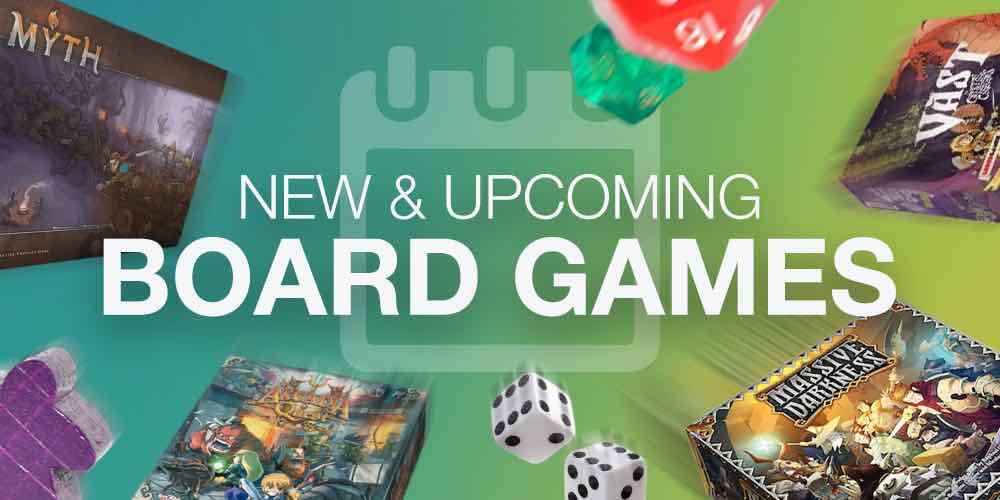
This game is nothing but roll and move, even the cards can’t save it. It’s has very little educational value. I gave my copy to my kids school, didn’t want it in the collection. Jonathan’s own game has more educational value than this.
I’d disagree that it’s “nothing but roll and move”—the movement cards DO change things, because it gives you additional choice in where you can land. As far as educational value, I think that depends on how you use it. Just playing the game, by itself, will only teach you very basic things like a few terms for subatomic particles. In the hands of a teacher (or someone who is actively interested in the educational portion), the game can be used as a starting point and visual aid that’s significantly more interesting than a diagram in a book.
Nice to have such divergent views on a creative board game and speaking of one and during this World Cup season, come check out KickShot Soccer Board Game at http://www.kickshot.org. I created KickShot for ages 5 through adults, three different levels.
Thank you.
I applaud the creators for taking a concept to a product and market. That is a long journey.
Aziz Makhani
Creator of KickShot Soccer Board Game
Moscow, Idaho